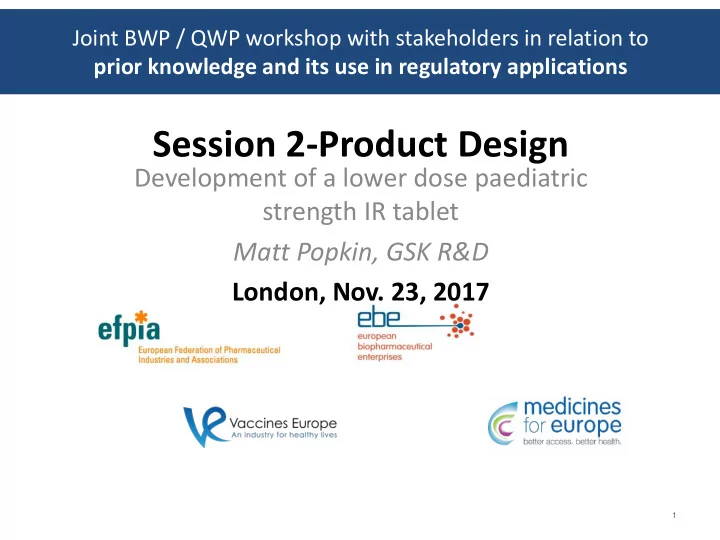

Joint BWP / QWP workshop with stakeholders in relation to prior knowledge and its use in regulatory applications Session 2-Product Design Development of a lower dose paediatric strength IR tablet Matt Popkin, GSK R&D London, Nov. 23, 2017 1
Focus of this Case Study • Design of the Tablet, e.g.: • Selection of excipients • Design of the formulation • Analytical methods • Design and Selection of the Manufacturing Process, e.g.: • Selection of Unit Operations and Equipment • Scale-up technical transfer and validation of the batch manufacturing process • Development of the Control Strategy, e.g.: • Identification of CQAs • Identification of CPPs and critical material attributes 2
Product Overview • “Paediatric Regulation” aims to facilitate the development and accessibility of age-appropriate paediatric medicines. This aim should be achieved without subjecting children to unnecessary clinical trials and without delaying the authorisation of medicinal products for other age groups “ EMA/CHMP/QWP/805880/2012 • Paediatric formulations are likely to heavily leverage prior knowledge of the original product • Learnings from this case study are considered widely applicable
Overview 50 mg dose, Immediate release tablet, once daily dosing API is BCS class 2 Parent Tablet Paediatric Tablets 50 mg dose, Immediate release tablet, 25, 10 mg dose, immediate release once daily dosing tablet, once daily dosing 300 mg, coated tablet 150, 100 mg, coated tablets for ease of use Parallel Paediatric 50 mg MAA Development plan Development of 50 mg tablets P3 clinical P3 clinical Year 1 Year 2 Year 3 Year 4 P1/2 children Development of 25, 10 mg tablets 10, 25 mg MAA 4
Overview of the 50, 25 and 10 mg tablets Granulate • Extra granular excipients • 12 mg 288 mg Granulate • Extra granular excipients • 6 mg 144 mg • Extra granular Granulate excipients* 58 mg • 42 mg Trade-off: reuse of the granule means identical tablet core cannot be used, as the tablet was too small; * Additional extra granular excipients to add bulk were DC grade intra granular excipients
Example: Comparison of excipient selection and compatibility in P2.2 50 mg tablet 10, 25 mg tablets • • Discriminating method developed Discriminating method developed • Use of well known and understood excipients, controlled to pharmacopeial standards • Re-use of existing granule • Studies on compatibility and stability – • Reference made in P2.2 and other Degradation mechanism identified by long modules to 50 mg granule and formulation term stress storage comparison • Tablet DOE to understand and develop the pivotal formulation – study of impact on stability, dissolution….. • Shelf life confirmed in ICH Studies • Shelf life confirmed in ICH Studies 6
Rapid development and scale-up of the paediatric tablets Where was the focus of development? Green shows low risk, based on prior knowledge: Trade off: same granule utilised • Design – Not repeated for 10, 25 mg Formulation composition – Excipient compatibility – Stability – Analytical methods - appropriately discriminating for BCS II Completed for 10, 25 mg – Impact/suitability of API properties – Rapid BE and PK Comparison between 50 mg and 10, 25 mg in-vitro & during clinical studies. Streamlined for 10, 25 mg • Manufacturing process and Control Strategy – Selection of the manufacturing process and process equipment – Identification of CPPs and critical material attributes – Scale-up, technical transfer and validation of the batch manufacturing process Trade off: same granule and manufacturing equipment and scale used 7
Example: Stability of 10, 25 mg Tablets • Prior knowledge of the 50 mg (stability well understood); 2 year shelf-life should be readily achievable • Batch Selection: • Commercial-scale granulation and compression; pilot scale coating • Stability conditions: • >2 years ambient and 6m accelerated • ICH stability was on critical path until change in clinical plan • Data confirmed assumptions of good tablet stability • ICH stability package supported the MAA; was it needed? • In the future, greater leverage of prior knowledge supported by accelerated stability modelling (ASM)? 8
Overall Summary • Ability of leverage prior knowledge of 50 mg tablet was key to rapid development of the 10 and 25 mg tablets – Product design, manufacturing process and control strategy • Learnings: – Trade-offs/restrictions in design of the tablet and manufacturing process to ensure prior knowledge was relevant – Knowledge of the PK of the 50 mg tablet simplified PK evaluation – Referencing prior knowledge from the 50 mg file was a challenge. – Relevant additional data (e.g. stability and manufacturing experience) were available from the 50 mg tablet at the time of the paediatric file- how could this be referenced? – Could development have been further streamlined based on the prior knowledge (e.g. stability?) 9
Reflections • • Questions posed by the Case Study Challenges/Answers • How was prior knowledge leveraged to • In multiple ways – selection of the granule, scale up, facilitate development? control strategy, PK - generally applicable to PLEs such as paediatric products • Trade-offs were required to ensure the prior knowledge was relevant – re-use of granule, manufacturing process… • Some re-use of data where relevant; implied cross • How was the prior knowledge presented referencing in the submission? • For rapid development of age-appropriate formulations, it is important that prior knowledge • used to support development can be: How can more consistent and extensive use of prior and platform knowledge • Clearly identified and referenced in the submission accelerate development and improve • Supported by mechanisms for cross-referral access to medicines? • Supported by all available knowledge, including that on the manufacturing site 10
Joint BWP / QWP workshop with stakeholders in relation to prior knowledge and its use in regulatory applications Thank-you! 11
Recommend
More recommend